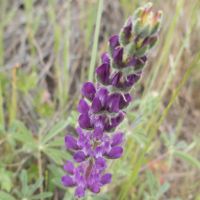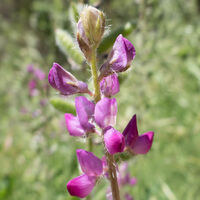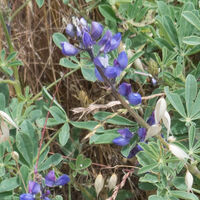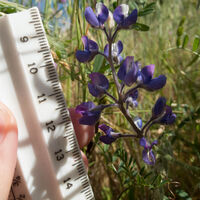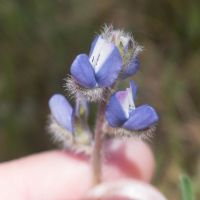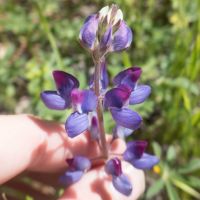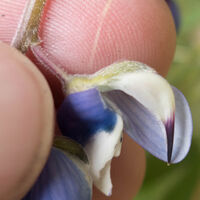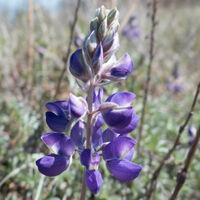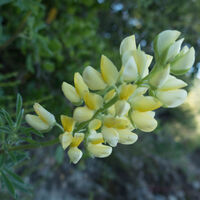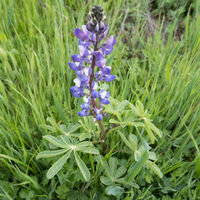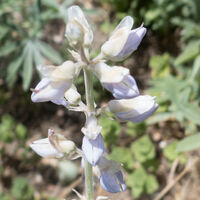lupines
genus Lupinus
Member of
legume family (family Fabaceae)
dicots (class Magnoliopsida)
flowering plants (subphylum Angiospermae)
Except for old historical records and extremely rare examples that I don't expect to encounter, there are no other wild species of this genus in the bay area.
Camera angles:
- overall (with scale)
- whole inflorescence (with scale)
- flower and pedicel close up (with scale)
- leaf top close up (with scale)
- leaf bottom
- stem close up
- keel hairs (upper & lower margins)
- banner back hairs (best seen in bud, where it encloses the entire flower)
Key features:
- total height
- shrub, decumbent, or “regular”
- stem hair character (if any)
- stem hollow or firm
- leaflet number, length, and width
- leaf adaxial and abaxial hair character (if any)
- inflorescence length; whorled, spiraled, or not
- pedicel length
- flower color
- banner length vs. width
- keel upper and lower margins ciliate or partially ciliate, claw to tip
Lupine parts labeled in close view:
- banner is top (bent) petal
- wings are lower two petals (attached at the tip)
- keel is two fused petals often hiding between/below the wings
Fantastic series of close-up photos with explanations.
The bracts are thin/linear sprouts immediately subtending each sepal of the calyx.
cotyledons persistent
Lupinus luteolus
- habit: annual 30–75 cm, sparsely hairy or in age glabrous, appearing glaucous; cotyledons disk-like, persistent [example] at plant base, or leaving circular scar
- stem: hard, rigid
- leaf: petiole 2–5 cm; leaflets 7–9, 10–30 mm, 4–9 mm wide, adaxially generally hairy
- inflorescence: 5–22 cm, flowers in generally crowded whorls; peduncle 4–15 cm; pedicels 1–3 mm; bracts 5–11 mm, reflexed, hairy, persistent
- flower: 10–16 mm; calyx upper lip 3–5 mm, lower 6–10 mm, appendages generally 0; petals generally pale yellow (± pink or bright blue), wings generally ciliate on upper (lower) margins near claw
- keel upper, lower margins equally ± densely ciliate
- Jasper, Alum Rock, Grant, Mt. Diablo foothills
Lupinus microcarpus
- habit: annual 10–80 cm, sparsely to densely hairy; cotyledons disk-like, persistent [example] at plant base, or leaving circular scar
- stem: clearly hollow, at least below
- leaf: petiole 3–15 cm; leaflets 5–11, generally 9, 10–50 mm, 2–12 mm wide, occasionally linear, adaxially glabrous
- inflorescence: 2–30 cm; peduncle 2–30 cm; pedicels 0.5–5 mm; bracts 3.5–12 mm, reflexed, persistent
- flower: 8–18 mm; calyx upper lip 2–6 mm, lower 5–10 mm, appendages generally 0; petals white to dark yellow, pink to dark rose, or lavender to purple, wings generally ciliate on upper (less often lower) margins near claw
- keel upper margins ciliate [only proximal section?], lower less so or glabrous near claw
- common
lower keel margin ciliate middle to claw
upper keel margin ciliate middle to claw or glabrous
flowers spiralled
Lupinus hirsutissimus
- habit: annual 20–100 cm (often > 100 cm after fire), short-appressed- and stiff-spreading-stinging-hairy
- leaf: petiole 4–9 cm; leaflets 5–8, 20–50 mm, 10–20 mm wide
- inflorescence: 10–30 cm, flowers spiralled; peduncle 5–8 cm; pedicels 2–5 mm; bracts 4–5 mm, generally persistent
- flower: 12–18 mm; calyx 6–10 mm, lips ± equal, upper deeply lobed; petals dark pink to magenta, drying ± purple, banner spot ± yellow, in age magenta
- keel upper margins glabrous, lower densely ciliate middle to near claw
- Fremont Older, Castle Rock, Nisene Marks
Lupinus truncatus
- habit: annual 20–30(50) cm, finely hairy, generally appearing glabrous
- leaf: petiole 3–10 cm, flat, leaflet-like; leaflets 5–8, 20–40 mm, 2–5 mm wide, linear, adaxially glabrous, tip generally truncate
- inflorescence: 3–25 cm, flowers sparse, spiralled; peduncle 3–10 cm; pedicels 2–4 mm; bracts 2–5 mm, persistent
- flower: 8–13 mm; calyx 3–4 mm, lips ± equal, upper deeply lobed; banner, wings magenta, banner spot ± yellow, dark magenta in age
- keel tip stout, blunt, upper, lower margins ciliate middle to claw
- along hwy 17 corridor, including Bear Creek Redwoods
flowers whorled
plant fleshy
Lupinus succulentus
- habit: annual, often appearing perennial herb, 20–100 cm, sparsely hairy, fleshy
- leaf: petiole 6–15 cm; leaflets 7–9, 20–60 mm, 7–20 mm wide, adaxially glabrous
- inflorescence: 9–15 cm, flowers whorled; peduncle 5–9 cm; pedicels 3–7 mm; bract 3–5
- flower: 12–18 mm; calyx 4–7 mm, lips ± equal, upper lobed; petals generally blue-purple (white, pink, lavender), banner spot white, magenta in age, wings sparsely ciliate on upper margins near claw
- keel upper, lower margins ciliate near claw, glabrous from middle to tip
- common
lower keel margin glabrous
upper keel margins glabrous or ciliate only near tip
flowers whorled
banner longer than wide
pedicels 1–3.5 mm
miniature lupine
Lupinus bicolor
- habit: annual, 10–40 cm, hairy
- leaf: petiole 1–7 cm; leaflets 5–7, 10–40 mm, 1–5 mm wide, occasionally linear, adaxially generally ± glabrous
- inflorescence: 1–8 cm, flowers in (0)5 whorls; peduncle 3–10 cm; pedicels 1–3.5 mm; bract 4–6 mm
- flower: 4–10 mm; calyx upper lip 2–4 mm, deeply lobed, lower 4–6 mm; petals generally blue (light blue, pink, or white), banner longer than wide, spot white, in age magenta
- keel ± white, generally pointed, upper margins generally ciliate near tip
- note: vigorous plants with larger flowers may be confused with Lupinus nanus.
- very common
big pod lupine
Lupinus pachylobus
- habit: annual 15–40 cm, hairy [dense & bristly, especially on the calyx]
- leaf: petiole 4–8 cm; leaflets generally 7, 20–25 mm, 2–5 mm wide
- inflorescence: 1–6 cm, flowers generally whorled; peduncle 3–12 cm; pedicels 1–2.5 mm; bract ± 6 mm
- [may have fewer whorls than miniature lupine (Lupinus bicolor)]
- flower: 7–9 mm; calyx 4.5–6 mm, lips ± equal; petals blue, banner longer than wide, spot white, in age dark magenta
- keel blunt, glabrous
- Mt. Diablo [and rarely elsewhere?]
banner as wide or wider than long
pedicels 3–7 mm
fleshy lupine
Lupinus affinis
- habit: annual 20–50(60) cm, hairy
- leaf: petiole 3–10 cm; leaflets 5–8, 20–50 mm, 4–11 mm wide
- inflorescence: 4–20 cm, flowers whorled; peduncle 5–18 cm; pedicels 3–6 mm; bract 5–7.5 mm
- flower: 8–12 mm; calyx 5–7 mm, lips ± equal; petals blue, banner as wide or wider than long, spot white
- upper keel margins with (occasionally inconspicuous) tooth near middle, ciliate from tooth to near tip
- common
sky lupine
Lupinus nanus
- habit: annual 10–60 cm, hairy
- leaf: petiole 2–8.5 cm; leaflets 5–9, generally 7, 10–40 mm, 1–12 mm wide, occasionally linear, adaxially hairy
- inflorescence: 2–20 cm, flowers generally whorled; peduncle 2–15 cm; pedicels 2.5–7 mm; bract 4–12 mm
- flower: 6–15 mm; calyx 4–8 mm, lips ± equal, upper deeply lobed; petals blue (light blue), lavender, pink, or white, banner as wide or wider than long, spot white
- keel upper margins without tooth, ciliate near tip, lower glabrous
- common
banner longer than wide
pedicels 1–3.5 mm
Lupinus bicolor
- habit: annual, 10–40 cm, hairy
- leaf: petiole 1–7 cm; leaflets 5–7, 10–40 mm, 1–5 mm wide, occasionally linear, adaxially generally ± glabrous
- inflorescence: 1–8 cm, flowers in (0)5 whorls; peduncle 3–10 cm; pedicels 1–3.5 mm; bract 4–6 mm
- flower: 4–10 mm; calyx upper lip 2–4 mm, deeply lobed, lower 4–6 mm; petals generally blue (light blue, pink, or white), banner longer than wide, spot white, in age magenta
- keel ± white, generally pointed, upper margins generally ciliate near tip
- note: vigorous plants with larger flowers may be confused with Lupinus nanus.
- very common
Lupinus pachylobus
- habit: annual 15–40 cm, hairy [dense & bristly, especially on the calyx]
- leaf: petiole 4–8 cm; leaflets generally 7, 20–25 mm, 2–5 mm wide
- inflorescence: 1–6 cm, flowers generally whorled; peduncle 3–12 cm; pedicels 1–2.5 mm; bract ± 6 mm
- [may have fewer whorls than miniature lupine (Lupinus bicolor)]
- flower: 7–9 mm; calyx 4.5–6 mm, lips ± equal; petals blue, banner longer than wide, spot white, in age dark magenta
- keel blunt, glabrous
- Mt. Diablo [and rarely elsewhere?]
banner as wide or wider than long
pedicels 3–7 mm
Lupinus affinis
- habit: annual 20–50(60) cm, hairy
- leaf: petiole 3–10 cm; leaflets 5–8, 20–50 mm, 4–11 mm wide
- inflorescence: 4–20 cm, flowers whorled; peduncle 5–18 cm; pedicels 3–6 mm; bract 5–7.5 mm
- flower: 8–12 mm; calyx 5–7 mm, lips ± equal; petals blue, banner as wide or wider than long, spot white
- upper keel margins with (occasionally inconspicuous) tooth near middle, ciliate from tooth to near tip
- common
Lupinus nanus
- habit: annual 10–60 cm, hairy
- leaf: petiole 2–8.5 cm; leaflets 5–9, generally 7, 10–40 mm, 1–12 mm wide, occasionally linear, adaxially hairy
- inflorescence: 2–20 cm, flowers generally whorled; peduncle 2–15 cm; pedicels 2.5–7 mm; bract 4–12 mm
- flower: 6–15 mm; calyx 4–8 mm, lips ± equal, upper deeply lobed; petals blue (light blue), lavender, pink, or white, banner as wide or wider than long, spot white
- keel upper margins without tooth, ciliate near tip, lower glabrous
- common
shrub
Lupinus chamissonis
- habit: shrub 50–200 cm, silvery, densely appressed-hairy
- stem: erect
- leaf: cauline; stipules 8–10 mm; petiole 1–3.5 cm; leaflets 5–9, 10–25 mm
- inflorescence: 5–20 cm, flowers ± whorled; peduncle 2–6 cm; pedicels 4–8 mm; bract 7–10 mm
- flower: 8–16 mm; calyx upper lip 5–7 mm, deeply lobed, lower 7–9 mm, entire; petals light violet to blue, banner back densely hairy, spot yellow
- keel upper margins glabrous, lower ± ciliate
- common in SF, also found near Cowell
Lupinus albifrons
- habit: subshrub, shrub, < 500 cm, hairy, generally silver (± green)
- stem: decumbent to erect
- leaf: cauline, clustered near base or not, hairy; stipules 6–20 mm; petiole 1–8 cm; leaflets 6–10, 10–45 mm
- inflorescence: 4–30 cm, flowers generally not to loosely whorled; peduncle 5–13 cm; pedicels 3–10 mm; bract 4–15 mm
- flower: 9–16 mm; calyx upper lip 6–8 mm, deeply divided, lower 6–10 mm, entire to 3-toothed; petals violet to lavender, banner back generally hairy (best seen in buds), spot generally yellow (to white) turning purple
- keel generally unlobed near base, upper margins generally ciliate middle to tip, lower glabrous
- very common
Lupinus arboreus
- habit: shrub 50–200 cm, green-glabrous to silver-hairy
- stem: woody, erect
- leaf: cauline; stipules 8–12 mm; petiole 2–3(6) cm; leaflets 5–12, 20–60 mm
- inflorescence: 10–30 cm, flowers whorled or not; peduncle 4–10 cm; pedicels 4–10 mm; bract 8–10 mm
- flower: 14–18 mm; calyx upper lip 5–9 mm, 2-toothed, lower 5–7 mm, entire; petals generally yellow (rarely lilac to purple), banner back glabrous (best seen in buds), spot darker or not to white
- keel upper margins ciliate claw to tip, lower glabrous
- very common near the pacific coast, rare elsewhere
other perennials
Lupinus latifolius
- habit: perennial herb 30–240 cm, green, glabrous to hairy, not fleshy
- stem: erect
- leaf: cauline; stipules 5–10 mm; petiole 4–20 cm; leaflets 5–11, 40–100 mm, abaxially ± hairy, adaxially glabrous to hairy
- inflorescence: 16–60 cm, open, flowers whorled or not; peduncle 8–20 cm; pedicels 2–12 mm; bract 8–12 mm
- flower: 8–18 mm; calyx upper lip 5–10 mm, entire to 2-toothed, lower 4–8 mm, entire or notched; petals blue or purple to white, banner back glabrous, spot generally white to ± yellow turning purple
- keel upper margins ciliate claw to middle, glabrous from middle to tip, lower generally ciliate [?]
- common
Lupinus polyphyllus ssp. polyphyllus
- habit: perennial herb 20–150 cm, green, glabrous or sparsely hairy
- stem: erect, stout, generally hollow
- leaf: basal and cauline; stipules 5–30 mm; petioles 3–45 cm, upper shorter; leaflets 9–17, 40–150 mm, abaxially ± strigose, adaxially glabrous
- inflorescence: 6–40 cm, open, flowers ± whorled; peduncle 3–13 cm; pedicels 3–15 mm; bract 7–11 mm
- flower: 9–15 mm; calyx lips 4–7 mm, entire; petals violet to lavender to pink to white, banner back glabrous, spot yellow to white occasionally turning red-purple
- keel upcurved, generally glabrous
- rare, in cooler areas
Lupinus formosus var. formosus
- habit: perennial herb 20–80 cm, densely hairy to tomentose, gray to silver; rhizomes 3–7 mm diam
- stem: spreading to erect, 3–4 mm diam
- leaf: cauline; stipules 4–15 mm; petiole 2–7 cm; leaflets 7–9, 25–70 mm; hairy, green-gray to silver
- inflorescence: 10–30 cm, flowers ± whorled; peduncle 3–7 cm; pedicels 3–7 mm; bract 4–14 mm
- flower: 10–14 mm; calyx upper lip 7–11 mm, 2-toothed, lower 8–12 mm, entire to 3-toothed; petals purple, banner back glabrous, spot white or not
- keel upcurved, glabrous
- common
Lupinus variicolor
- habit: perennial herb, subshrub, 20–50 cm, generally dense-appressed or -spreading-silver-hairy
- stem: prostrate to decumbent, not weak
- leaf: cauline, often appearing clustered near base 1st year; stipules 7–8 mm; petiole generally 4–10 cm; leaflets 6–9, 20–35 mm
- inflorescence: 6–15 cm, flowers ± whorled or not; peduncle 4–12 cm; pedicels 4–12 mm; bract 4–7 mm
- flower: 11–16 mm; calyx upper lip 7–8 mm, 2-toothed, lower 8–9 mm, generally entire; petals white, yellow, rose, or purple, often on 1 petal, banner back glabrous, spot 0
- keel upper margins ciliate, lower glabrous
- common along pacific coast and east bay from Chabot north
Toxicity of blue bonnet, lupine (Lupinus spp.):
4 – Ingestion of these plants, especially in large amounts, is expected to cause serious effects to the heart, liver, kidneys or brain. If ingested in any amount, call the poison center immediately.
14 observed taxons / 6 unobserved taxons / 4 keys
Locations: Months: For more details, use advanced search.
Chris’s observations: 298 (157 are research grade)
Taxon info: iNaturalist – Calflora – Jepson eFlora – FNA
Bay Area species: iNaturalist – Calflora
